(This article has been written 80 years after Dachau Concentration Camp opened its doors to spearhead the most horrific crimes in the history of the world. Warning: This article contains adult content and is not suitable for children. It contains content and images that some readers may find disturbing.
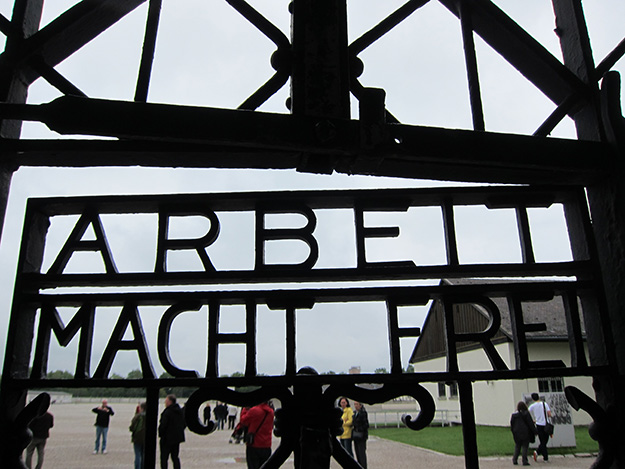 Most prisoners entered Dachau through this gate The sign reads “Arbeit macht frei” (work makes one free). Image by Jeaneane Payne
Most prisoners entered Dachau through this gate The sign reads “Arbeit macht frei” (work makes one free). Image by Jeaneane Payne
|
In the small but beautiful Bavarian village of Dachau, Germany, just north of Munich, lies a concentration camp in which over 200,000 prisoners from more than 30 countries were held between 1933 and 1945. Approximately 26,000 are believed to have died in the camp either from disease, malnutrition, or suicide.[1] Many thousands were burned in the crematorium inside the camp.
On September 6, 2012 my daughter, son-in-law, their dear German friend Neal began our drive from Southwest Germany to Bavarian Germany. Our trip was mostly in silence due to anticipation of our visit to Dachau Concentration Camp. Arriving in Dachau in the early evening hours, we checked into the lovely Götz Hotel, enjoyed a fabulous Bavarian dinner at a nearby restaurant, and walked throughout the beautiful city streets in the brisk evening chill. As we crawled underneath down comforters on comfortable beds in separate rooms, we didn't know the fullness of what the following day had in store for us.
Neal, age 32, is of Bavarian German descent. His last name is being withheld for his protection. Born in Bavaria, Straubing, he spent the first 7 years of his life in Bavaria, NATO headquarters in the Netherlands. He lived in Cologne for 6 years and then finished school in Germany where he studied philosophy and history at the University of Friedrich Wilhelm Unversität zu Bonn. A brilliant architectural engineer, he spills out Germany's history in endless volumes. His grandfather was a Nazi war criminal, an SS agent stationed at Dachau. As I was planning my trip to Germany to visit my daughter and son-in-law, Neal asked if he could travel to Dachau from Southwest Germany with us. He speaks fluent English.
I had been Skyping with Neal for several months interviewing him about his grandfather's involvement in the SS, listening to his own stories of how his grandfather's choices had formed his own choices in life, and learning about his father's life as the son of a Nazi war criminal. His grandfather was a volunteer in the SS. "He was proud of his involvement with the SS," Neal said. "He never showed remorse for his actions." According to Neal, his grandfather was originally stationed in a city which was victim to "Night of Broken Glass", a night when the Nazis burned down every synagogue in Germany. The Nazis led attacks against Jews throughout Nazi Germany and parts of Austria on November 9-10, 1938. Over 7,000 Jewish-owned businesses were destroyed, more than 1,000 synagogues were burned, and at least 91 Jews were killed. City streets were left covered with broken glass, thus the name "Night of Broken Glass".
 Admissions register of the Dachau concentration camp from November 10, 1938 (excerpt)
Admissions register of the Dachau concentration camp from November 10, 1938 (excerpt)
The first to arrive at the Dachau concentration camp were the Munich Jews. The Jews from the Reich territory committed in the walk of the "Reichskristallnact" ("Night of Broken Glass"), number more than 11,000 were packed together in just a few barracks. The above imager is a painting of roll call in the Dachau concentration camp at the end of November 1938. The painting was done by painter and graphic artist David Ludwig Bloch who was arrested after "Reichskristallnact". He remained imprisoned in the Dachau concentration camp until the middle of December 1938. In April 1940 he succeeded in migrating to Shanghai. It was there he painted this picture.
|
Neal had never visited Dachau. The pain of knowing his grandfather was a major participant in the events that took place there was more than he could bear to face alone. "My grandparents (paternal) both were convinced Nazis. My father had a very hard time throughout his life dealing with that. He was curious and started to ask questions but never got answers. My grandparents felt they didn't need to justify themselves to their son."
Several years ago, Neal and his father put them into their car. They didn't tell them where they were going and drove them to Nordhausen, the closest concentration camp to where they lived. The grandmother willingly got out of the car, but the grandfather refused.
I had anticipated having the opportunity to interview Neal's grandfather during my most recent visit to Germany, but he passed away three months prior to my arrival. He died at 96.
| |
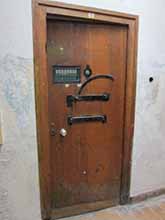 Door to a prison cell at Dachau. Image by Jeaneane Payne
Door to a prison cell at Dachau. Image by Jeaneane Payne
|
After 1934, the running of Germany's concentration camps was placed under the total authority of the SS. There were 70,000 members of the SS involved in crimes in German concentration camps. Only 1700 were tried after the war.[2] According to the Nuremberg Trials, as well as many war crimes investigations and trials conducted since then, the SS was responsible for the vast majority of Nazi war crimes. It was the primary organization which carried out the Holocaust.[3]
Neal's maternal grandfather was part of the German military, but he didn't like it. He was a young man who realized he had fallen into all the lies. He was sent to Russia and captured by the Russians who put him into the Soviet Gulag, a massive system of forced labor camps. Throughout its history some 18 million passed through the prisons and camps of the Gulag. Under Stalin, labor camp prisoners became an important resource for the construction of many industries, including the nation's railways and roads, mining operations, and the timber industry. Millions suffered in the camps, many guilty of no crime.[4]
Neal's father, married at 24 with a child on the way, desired to become a lawyer. Joining the military was the easiest solution to resolve his financial issues associated with school expenses. He felt a duty to protect the new democracy from an attack of another dictatorship. Communists were living next door to him. "He was very concerned because there were so many signs of a dictatorship coming in from the past," said Neal. "The Nazis did not become democrats overnight after the war was over. The transition can be compared to the racial segregation in the 60s in the United States." Long after the war was over, Neal's father found a sign at the front of a concentration camp indicating the Nazis wanted to keep the ideology alive. That was in the 70s.
"Germans today prefer to use the term 'death camps' as opposed to concentration camps because the only purpose of the camps was to kill people in an industrialized way," stated Neal.
Our visit to Dachau on September 7, 2012 began with a stop at MacDonald's. The friendliness of the villagers and the beauty of the city of Dachau would never lead one to believe it was a city where some of the world's most horrific crimes had taken place. There was an overcast that day, but the temperature was very pleasant.
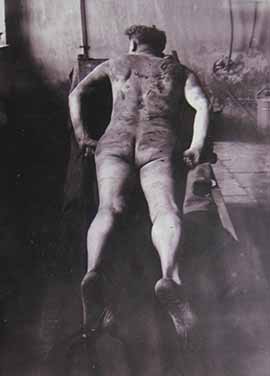
Nurembourg businessman Louis Schloss died on May 16, 1933 at Dachau as a result of a beating. To give the incident the appearance of a suicide, he was hung on a hook with suspenders. The above image was taken on May 17, 1933 under the direction of the State Prosecution Office.
|
|
The historic, 1200 year old city of Dachau is famous for its amazingly diverse arts and cultural scene. Home to Bavarian kings, Dachau was an important European artist colony at the turn of the century. Little did anyone living in the village in 1933 know that a concentration camp had been established in their midst. The camp was built with a large, private garden entrance which did not create suspicion by outsiders. Most prisoners entered through a main gate which was located far beyond the main entrance.
It was 80 years ago when the Dachau concentration camp opened its gates on March 22, 1933 thus setting the stage for hundreds of such camps to be opened throughout Germany, Poland, and Austria.
"Dachau - the significance of this name will never be erased from German history. It stands for all concentration camps which the Nazis established in their territory." -- Eugen Kogon
As we arrived at the camp, bus loads of visitors were being brought in. People from all over the world were clustered at the camp's entrance to see what was behind its walls. A large visitor center included a bookstore filled with books about the Holocaust and memorabilia. I didn't purchase any of the books that I badly wanted thinking I could order them on Amazon.com upon my return to the states. However, the books sold there cannot be purchased in the United States. Sales are exclusive to the camp book store only.
The visitor center also contained a restaurant and a welcome center.
A very long path led from the visitor center to the main gate. Most prisoners entered through this gate under the sign “Arbeit macht frei” (work makes one free). The first to arrive at Dachau had been the Munich Jews brought in during the "Night of Broken Glass". Approximately 11,000 of these prisoners were put into just a few barracks following this night of terror.
As we entered the gate, a feeling that we were being taken back in time was set in place. The camp was just as it was during the period of the Holocaust. Each of us felt a need to be alone as we toured Dachau -- to be alone with our overwhelming thoughts and emotions. My daughter, Rebecca, and son-in-law Logan stayed together, but Neal and I ventured off separately from them. The aura from the events that occurred during the Holocaust was markedly present.
We soon learned that upon their arrival at Dachau, the prisoners were frequently sworn at, threatened, and beaten. They were lined in the corridor in front of the baths, and all of their body hair was shaven. Many prisoners were made to lean over a wooden trestle and then beaten with a bull whip by SS men.
Pole hanging was a method of torture used in interrogation as well as punishment. Victims were hung up by their wrists, swung back and forth, and beaten.
"These are the torments of hell! The whole body weight hangs from the arms that are twisted backward. And the monsters stand in front of you and laugh at your pain, ask you whether you now want to confess, slap you in the face and pull and tug at your body. When you stay silent they swing you, often they whip you at the same time." -- "The Powerful and the Helpless," prisoner account of Edgar Kupfer-Koberwitz (1940-1945 in the Dachau concentration camp) on pole hanging, 1957 (excerpt).
The Dachau barracks and dining hall were expected to be in pristine condition at all times.
"The shelves and walls of the wooden lockers always had to be so white, as if they had been freshly planed down. Not a single stain was to be visible … otherwise slaps in the face from the block elder followed, extra work duty … or a punishment report, the consequence of which was at least an hour of pole hanging." -- prisoner account of Adam Kozkowiecki (1940-1945 in the Dachau concentration camp), 1967 (excerpt)
It was reported by other prisoners that some were held so long in water, with their head in front while their legs were raised backward, until they drowned.
Throughout our tour of the camp, we discovered private rooms where visitors could find solitude to sort out their emotions. These rooms were places where one could go to privately weep or just sort things out in their own minds.
During the 5 hours we spent at Dachau, the most difficult for me was viewing the prison cells. The walk down a long corridor portrayed each cell as being more deplorable than that the last.
We carefully viewed every exhibit during our tour, taking in as much information as we could in the short 5 hours we had before the camp closed. After touring the main facilities, we decided to go as a group to visit the crematorium knowing this would be the most difficult part for each of us, particularly for Neal who knew his grandfather had a part in the effort by the SS of placing so many innocent people in the ovens.
The crematorium had been built at the backside of the camp, out of view and out of hearing range of the screams of many thousands of people as they were being place into the ovens. It was adjacent to the gas chamber which had been disguised as "showers". A sign is posted near the ovens that states "... even though it was never proven that the ovens were used, all the evidence remains." The fact that a second crematorium was built at Dachau indicates the ovens were utilized.
Upon arriving at the crematorium, each of us found something that attracted our attention first, and we again ventured off separately. After I toured the facilities there, I went outside and sat on a bench to rest and wondered how the others were faring. My thoughts raced as I wished I had been there to comfort the prisoners -- to let them know that someone from the outside world cared. My emotions held up pretty well during the entire tour even though my heart was aching.
I wondered where the rest of my party was, what they were viewing, what their thoughts were. A few minutes passed and I saw Neal sitting on a nearby bench with his head in his hands, weeping. I walked over to him. He stood up, and I hugged him for a long time as we both wept -- a moment in history.
| |
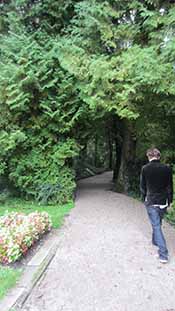 Neal leads us down a path to an area where many prisoners attempted to escape Dachau.
Neal leads us down a path to an area where many prisoners attempted to escape Dachau.
|
Rebecca and Logan had completed their tour about that time, and Neal said he wanted to take us to a garden nearby where bullet holes could be seen in the walls surrounding the camp. The feeling I got when walking down the trail leading to that scene was indescribable. There was a mysticism, a knowing that many had attempted to escape via this route but failed.
We walked back to the crematorium where many thousands of prisoners had been cremated. The original crematorium was built in the summer of 1940. By 1941 it was operating beyond capacity. It is believed that over 11,000 prisoners were cremated there. A new crematorium was quickly built, and countless thousands were cremated there.
The guard towers were still in place, just as they had always been. The massive roll call area had not been changed. It was a long walk back to the gate entrance as drops of rain occasionally fell on our tear-stained faces.
It was now 5:00 pm, and we were hungry. We decided to find a restaurant in Dachau to have dinner before beginning our drive back to Southwest Germany. We found a sandwich shop on a side street. They served hot, freshly baked bread for sandwiches that you could build yourself. I chose my ingredients, and the clerk rang up my order. Since I had been first in line, I found seating and awaited the others arrival at the table. It was at that time that my latent emotions fell apart. I began weeping and couldn't stop. By the time the others made it to the table, I was sobbing. Neal was the first to arrive and asked me what was wrong. I couldn't speak. He immediately thought he had said something to upset me. Rebecca and Logan got to the table and thought they had said something. After a few minutes I was able to speak and told them that I felt so helpless because I hadn't been there to help the prisoners and because no one believed the stories they had heard about what was going on behind the gates at Dachau in time to rescue the people from their tragedy.
We were all talkative on our drive back to Southwest Germany after having experienced an historic moment where Americans visited a death camp with the grandson of a Nazi war criminal. A strong bond had been created between us and a sincere desire to do what we could do individually to make the world a better place was instilled within us.
Logan expressed that it made him appreciate his service in the military more meaningful. Rebecca was overwhelmed at the injustice. As an activist, she wants to fight social injustice.
What took place at Dachau should never have occurred. It was all at the hands of a man who never grew up, who never dealt with his own insecurities and life's negative experiences. He went through his adult life wanting to kill anyone who didn't believe the same way he did.
Jews were not the only group Hitler's regime persecuted. His target included Jehovah's Witnesses, homosexuals, gypsies, Catholic priests, and Ukrainian political prisoners were also transported to Dachau."Of the nine million Jews who had resided in Europe before the Holocaust, approximately two-thirds were killed. Over one million Jewish children were killed in the Holocaust, as were approximately two million Jewish women and three million Jewish men. A network of over 40,000 facilities in Germany and German-occupied territory were used to concentrate, hold, and kill Jews and other victims."[5]
Prisoners at Dachau were required to assemble on the roll call ground every morning and even for roll call. Regardless of weather conditions, they were forced to stand to attention motionless for nearly an hour. At times, even the dead had to be dragged to the roll call ground to be counted. If the number of prisoners on roll call did not match the official head-count, this torture could last many hours. Often, sick and weak prisoners collapsed during roll call, and other prisoners were forbidden to help them. The SS carried out punishments on the roll call ground for all prisoners to see.
At the end of 1944, over 63,000 prisoners were in the Dachau concentration camp and its subsidiary camps. The horrific living conditions lead to the outbreak of a typhus epidemic.
The Holocaust started brewing in 1929 when the world economic crisis set in. The German Reich was hit extremely hard. Unemployment rose rapidly leaving millions of people without work. Many people starved. The Socialists and Communists presented themselves as godsends during this time which caught the attention of most people.
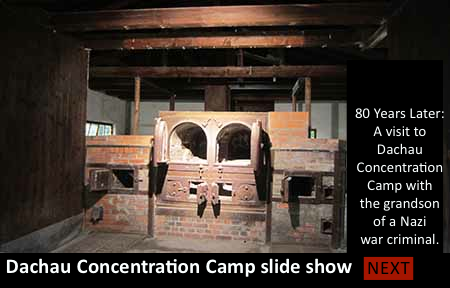
In 1919 the German Workers' Party (DAP) was established in Munich, Germany. Adolf Hitler became chairman when the party was renamed the National Socialist German Workers' Party (NSDAP) in 1920. In 1929 the party portrayed itself as being capable of solving the social and economic problems. There was a large following from aristocratic landowners and big industrial representatives. The NSDAP became the strongest political party during the Reichstag election of 1932.
As early as 1872, Jews were stereotyped and blamed for the negative effects of capitalism, greed, and exploitation. It was this mentality that began stirring the pot for Hitler's plan to exterminate Jews.
| |
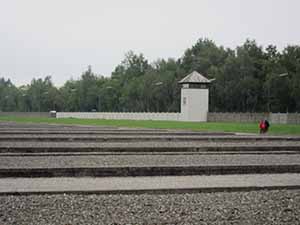 One of the guard towers at Dachau Concentration Camp. Image by Jeaneane Payne
One of the guard towers at Dachau Concentration Camp. Image by Jeaneane Payne
|
Ironically, as a child Hitler refused to conform to the strict discipline of his school. As an eight-year-old Hitler took singing lessons, sang in the church choir, and even considered becoming a priest. However, life changes caused him to experience a personality change. At age 34, Hitler was arrested after an attempt to overthrow the Bavarian government.[6] After his conviction, he spent five years in prison at Landsberg Prison where he wrote the first volume of Mein Kampf, a book now banned in Germany. The book laid out Hitler's plans for transforming German society into one based on race.
Hitler took over the regime in 1933. WWII started in 1938. His regime started feeding the ideology into children starting with kindergarten. "If you don't do what we tell you do, you will end up in a death camp." Basically, they started preparing for war and genocide in 1933.
On April 28, 1945 the International Red Cross reached an agreement on the surrender of Dachau concentration camp to US troops. On April 29 an advance team from the 7th Army under Brigadier General Henning Linden, accompanied by some journalists, officially accepted the surrender at the gate to the SS camp from the officiating commandant Heinrich Wicker.
At the same time, members of the 45th Infantry Division "Thunderbird" and advanced to the SS camp from the west. As they neared the camp, they came across a train full of dead bodies. Gunfire was exchanged with SS units and members of the SS were executed. Both United States units met in front of the Jourhaus, the main entrance to the Dachau camp. The camp prisoners had been waiting in unbearable tension and despair and began cheering as they came together to greet their liberators.
Today, Germany is very remorseful and ashamed of the horrific crimes that took place on their soil. The country is a wonderful place to visit. We have found Southern Germans and Bavarian Germans alike to be very friendly and accommodating, and their food is wonderful. Visiting Germany, as is true in any foreign country, we must realize it is not our country -- it is theirs. If we show them respect by adapting ourselves to their culture while we are there, they will treat us with respect in turn. If we expect and demand them to do things like we do here in America, we might be treated rudely. As for us, we have always been treated like kings and queens all throughout Germany.
1. Wikipedia. http://en.wikipedia.org/wiki/Dachau_concentration_camp. March 22, 2013.
2. Hillgruber, Andreas (1989). "War in the East and the Extermination of the Jews". In Marrus, Michael. Part 3, The "Final Solution": The Implementation of Mass Murder, Volume 1. The Nazi Holocaust. Westpoint, CT: Meckler. pp. 85–114. ISBN 0-88736-266-4.
3. International Military Tribunal (1946), Nazi Conspiracy and Aggression - Discussion and Detailed Verdict of the International Military Tribunal Finding the SS To Have Been a Criminal Organization, II, Washington, D.C.: USGPO, pp. 173–237
4. Gulag: Soviet Forced Labor Camps and the Struggle for Freedom. March 23, 2013.
5. Wikipedia. http://en.wikipedia.org/wiki/Holocaust. March 22, 2013.
6. Wikipedia. http://en.wikipedia.org/wiki/Hitler. March 22, 2013.

